Electric construction machines equal diesel machines in performance – with the added advantage of zero exhaust emissions and a better working environment. What is more, the conditions to support a smooth transition to electric construction sites and emission-free contracting are now here. This is confirmed by a multi-partner study, “Electric Worksite”, which has mapped the infrastructure needs for electric machines through testing at real-life worksites in Gothenburg, Sweden.
Societies today are transforming towards more sustainable city planning. Fossil-fuel free construction plays a major part in accelerating that shift and making progress towards national and global climate, environment, and air quality goals. The electrification of the construction sector will greatly contribute to a reduction in greenhouse gas emissions, noise pollution, and other harmful emissions, ensuring it plays a central role in sustainable community building.
In parallel with rising demand for emission free construction contracting and a growing market for electric machines, the need for collaboration between all players across the value chain is also increasing to ensure the infrastructure is up to par for the change. This puts new demands on the energy supply and electrical system, among other areas.

Collaboration and competence to accelerate the shift
The goal of the Electric Worksite project was for several players across the supply chain to come together to gain an important understanding of the opportunities and needs when putting to work electric equipment in urban applications. The project, which recently presented its final results, has had a clear focus on the system perspective, testing electric machines, energy storage and charging infrastructure in different urban sites to clarify the varied needs across interconnected technical and organisational systems.
The tests were carried out in real-life construction sites with electric-powered wheeled and crawler excavators, wheel loaders and load carriers, weighing between 3.5-30 tons. Some of which were battery-powered and others cable-connected. The study concluded that all tests have been successful, with the main learnings being:
- Electric construction machines can perform the same work to the same standard as fossil-fueled variants in urban construction projects.
- Workers in and around electric machines experience several positive effects in the handling of machines and the working environment.
- Like most construction projects in general, the success of electrification is based on foresight, planning, and flexibility.
New requirements for power supply are solved based on machine type and available electricity – such as electrical cabinets, mobile charging stations, cable-connected machines and potentially also energy storage units.
End customers need to be made aware of new opportunities and challenges with electric machines, as well as of existing business conditions and contracting requirements towards contractors and subcontractors.
Volvo CE is one of the collaborators which has played a key role in the research project, by project managing the tests and providing electric machines in various sizes and models, as well as technical solutions for charging such as mobile energy storage and cable management systems.
Bobbie Frank, Research leader at Volvo CE, with the grid-connected excavator from Volvo commented, “Electric machines are already available on the market and performing well, but the challenge can often be how to establish a reliable supporting infrastructure. This project confirmed that when all actors in the value chain around a construction site collaborate, both from the public and the private sector, we solve the infrastructure around it. In all tests, regardless of application and location, the electric machines performed as well as, if not better than, equivalent models with combustion engines, but without harmful emissions and disturbing noise”.
Driving progress with contracting demands
Municipalities and government bodies play an important role in enabling and driving the transition, for example by setting requirements for emission-free vehicles and machinery in the procurement of construction work, and by establishing clear city development goals for all societal players to work towards. The City of Gothenburg was keen to be involved in this project, seeing that there are many benefits in accelerating electrification within construction.
“As the City of Gothenburg is a major procurer of construction and civil engineering contracts, we can and want to be involved in leading the transition towards an emission-free industry. We also see many other benefits for both the surrounding environment and the working environment, such as reduced noise and improved air quality,” says Peter Lindgren, business developer for Electrified Transports at the Environmental Management Department, City of Gothenburg.
For the construction contractor NCC, the Electric Worksite has meant evaluating opportunities and challenges with electrification, together with other actors in the value chain.
“Once again, we can conclude that the most important take-away is that we need to get involved early in the project to plan for electrification – because the opportunities to influence emissions are greatest in the planning stage. To scale up the use of electric construction machines and vehicles, increased competence is also needed throughout the value chain. We also need electric machines to be demanded in the contracting by customers, and that they set requirements that drive the development forward,” says Pernilla Löfås, sustainability manager, NCC Infrastructure.